International Management Personal Interview Report: MGMT 4150 Analysis
VerifiedAdded on 2022/09/13
|9
|1801
|21
Report
AI Summary
This report presents an analysis of an international management personal interview assignment (MGMT 4150), focusing on the experiences of Mr. Rajib Banerjee, a civil engineer from India who has lived in the USA for ten years. The interview explores unexpected cultural differences, such as smoking habits and work culture, and the culture shock experienced by the interviewee. The report details difficulties faced, dreams, and cultural differences between the US and India, comparing these differences using Hofstede's Value Dimensions. The analysis covers power distance, individualism vs. collectivism, masculinity vs. femininity, uncertainty avoidance, long-term orientation, and indulgence vs. restraint. The report concludes that expatriates face significant cultural challenges and highlights the importance of understanding and adjusting to new cultural environments. The assignment includes the interview questionnaire and a scanned business card in the appendices.
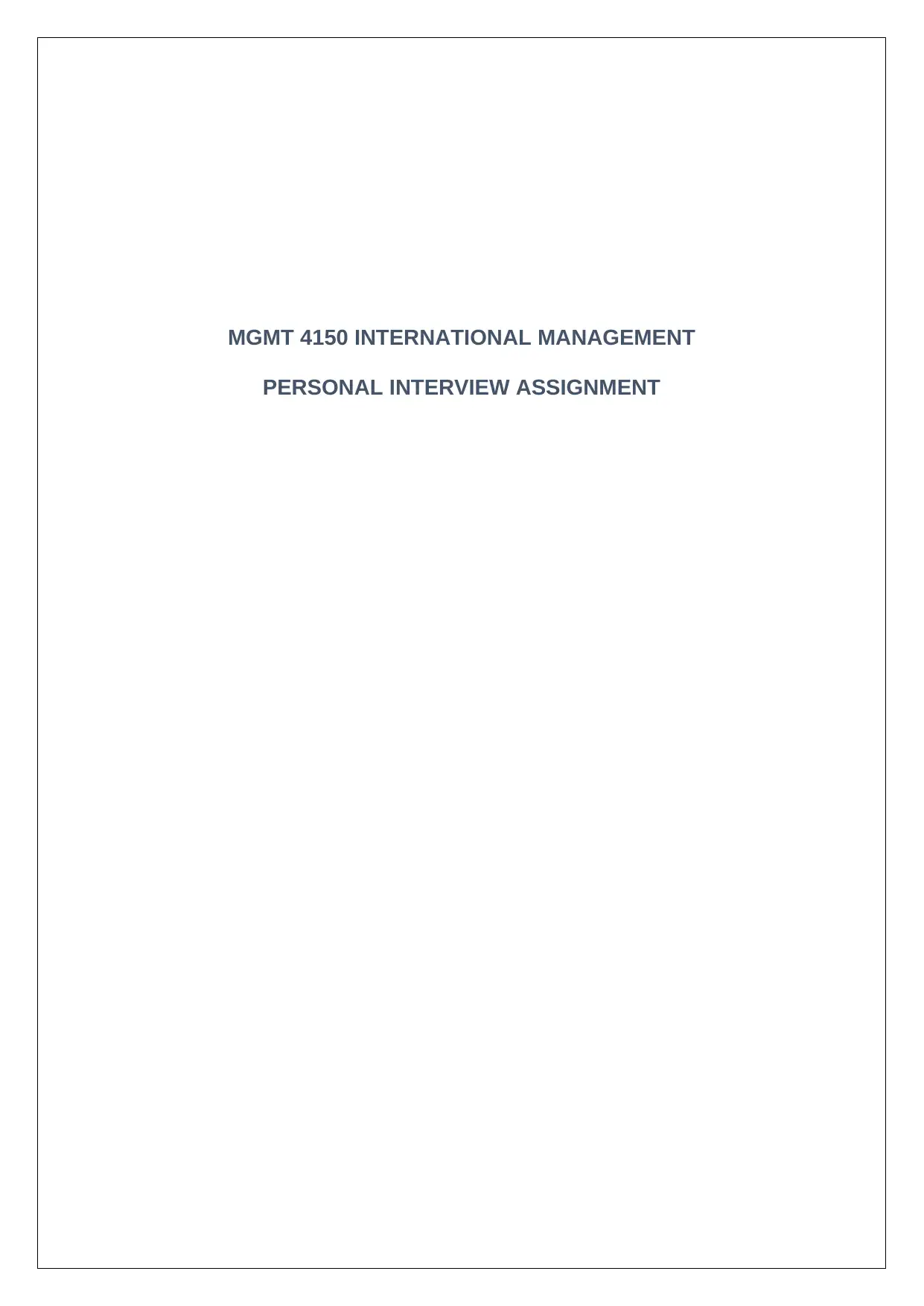
MGMT 4150 INTERNATIONAL MANAGEMENT
PERSONAL INTERVIEW ASSIGNMENT
PERSONAL INTERVIEW ASSIGNMENT
Paraphrase This Document
Need a fresh take? Get an instant paraphrase of this document with our AI Paraphraser
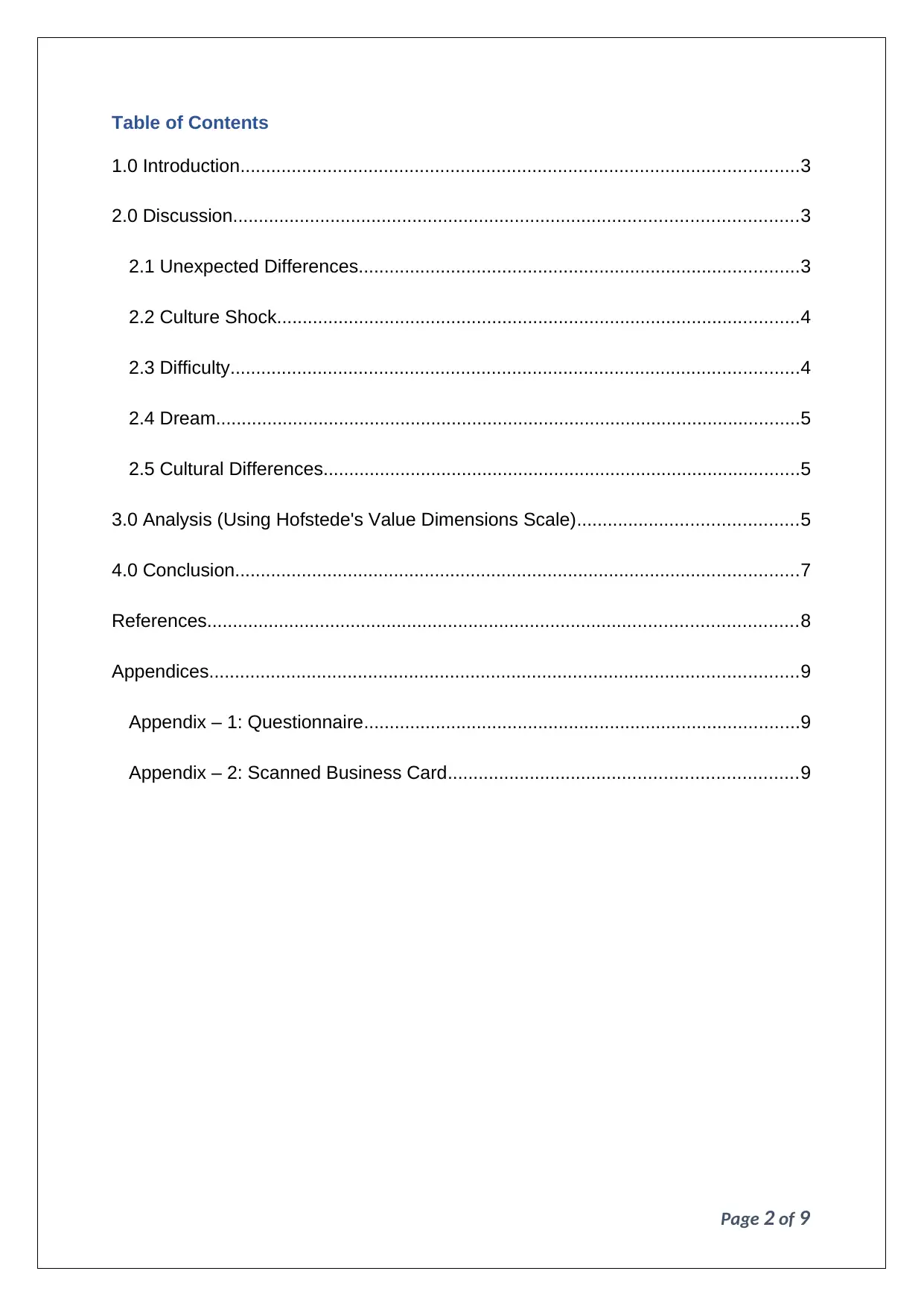
Table of Contents
1.0 Introduction.............................................................................................................3
2.0 Discussion..............................................................................................................3
2.1 Unexpected Differences......................................................................................3
2.2 Culture Shock......................................................................................................4
2.3 Difficulty...............................................................................................................4
2.4 Dream..................................................................................................................5
2.5 Cultural Differences.............................................................................................5
3.0 Analysis (Using Hofstede's Value Dimensions Scale)...........................................5
4.0 Conclusion..............................................................................................................7
References...................................................................................................................8
Appendices...................................................................................................................9
Appendix – 1: Questionnaire.....................................................................................9
Appendix – 2: Scanned Business Card....................................................................9
Page 2 of 9
1.0 Introduction.............................................................................................................3
2.0 Discussion..............................................................................................................3
2.1 Unexpected Differences......................................................................................3
2.2 Culture Shock......................................................................................................4
2.3 Difficulty...............................................................................................................4
2.4 Dream..................................................................................................................5
2.5 Cultural Differences.............................................................................................5
3.0 Analysis (Using Hofstede's Value Dimensions Scale)...........................................5
4.0 Conclusion..............................................................................................................7
References...................................................................................................................8
Appendices...................................................................................................................9
Appendix – 1: Questionnaire.....................................................................................9
Appendix – 2: Scanned Business Card....................................................................9
Page 2 of 9
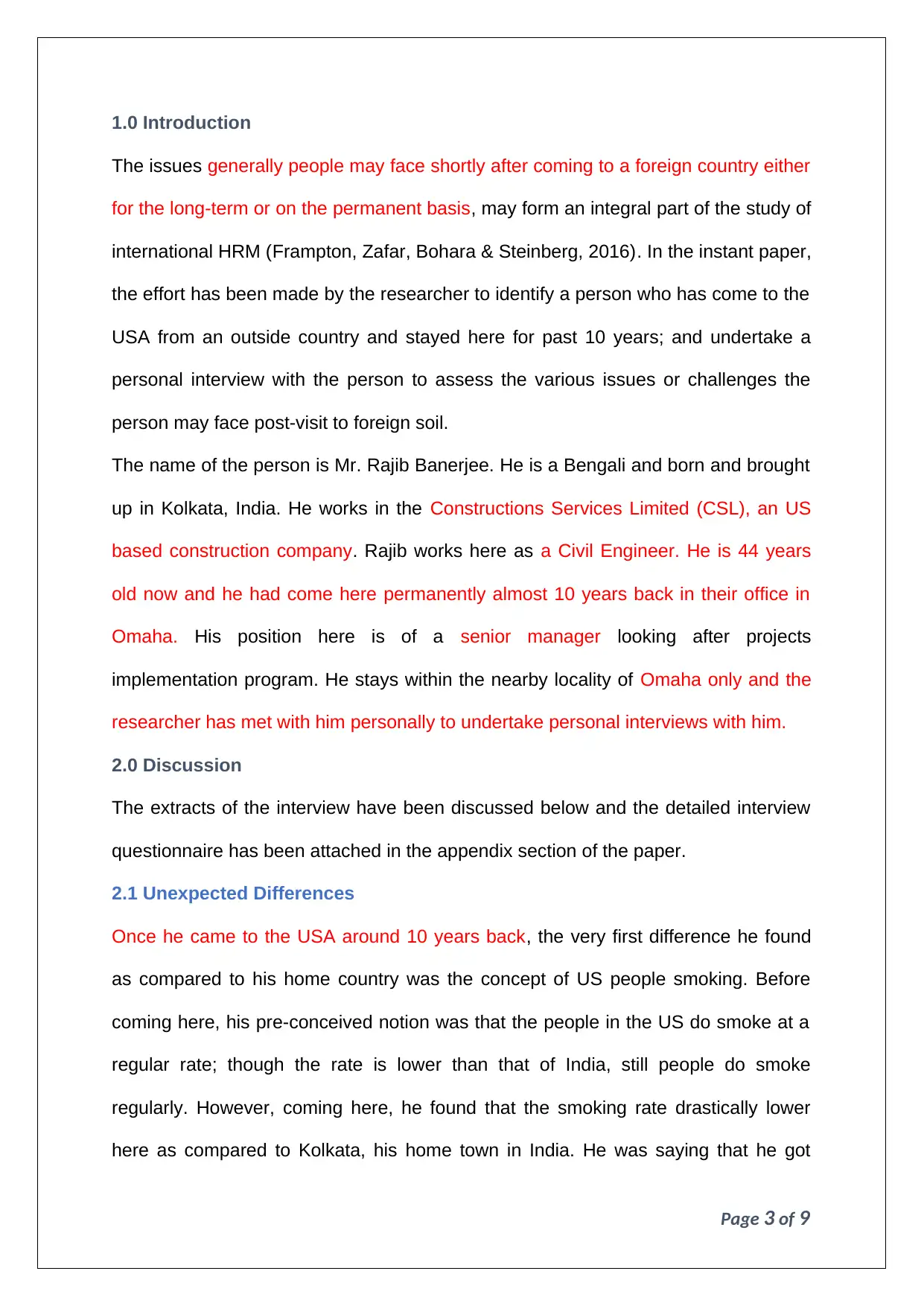
1.0 Introduction
The issues generally people may face shortly after coming to a foreign country either
for the long-term or on the permanent basis, may form an integral part of the study of
international HRM (Frampton, Zafar, Bohara & Steinberg, 2016). In the instant paper,
the effort has been made by the researcher to identify a person who has come to the
USA from an outside country and stayed here for past 10 years; and undertake a
personal interview with the person to assess the various issues or challenges the
person may face post-visit to foreign soil.
The name of the person is Mr. Rajib Banerjee. He is a Bengali and born and brought
up in Kolkata, India. He works in the Constructions Services Limited (CSL), an US
based construction company. Rajib works here as a Civil Engineer. He is 44 years
old now and he had come here permanently almost 10 years back in their office in
Omaha. His position here is of a senior manager looking after projects
implementation program. He stays within the nearby locality of Omaha only and the
researcher has met with him personally to undertake personal interviews with him.
2.0 Discussion
The extracts of the interview have been discussed below and the detailed interview
questionnaire has been attached in the appendix section of the paper.
2.1 Unexpected Differences
Once he came to the USA around 10 years back, the very first difference he found
as compared to his home country was the concept of US people smoking. Before
coming here, his pre-conceived notion was that the people in the US do smoke at a
regular rate; though the rate is lower than that of India, still people do smoke
regularly. However, coming here, he found that the smoking rate drastically lower
here as compared to Kolkata, his home town in India. He was saying that he got
Page 3 of 9
The issues generally people may face shortly after coming to a foreign country either
for the long-term or on the permanent basis, may form an integral part of the study of
international HRM (Frampton, Zafar, Bohara & Steinberg, 2016). In the instant paper,
the effort has been made by the researcher to identify a person who has come to the
USA from an outside country and stayed here for past 10 years; and undertake a
personal interview with the person to assess the various issues or challenges the
person may face post-visit to foreign soil.
The name of the person is Mr. Rajib Banerjee. He is a Bengali and born and brought
up in Kolkata, India. He works in the Constructions Services Limited (CSL), an US
based construction company. Rajib works here as a Civil Engineer. He is 44 years
old now and he had come here permanently almost 10 years back in their office in
Omaha. His position here is of a senior manager looking after projects
implementation program. He stays within the nearby locality of Omaha only and the
researcher has met with him personally to undertake personal interviews with him.
2.0 Discussion
The extracts of the interview have been discussed below and the detailed interview
questionnaire has been attached in the appendix section of the paper.
2.1 Unexpected Differences
Once he came to the USA around 10 years back, the very first difference he found
as compared to his home country was the concept of US people smoking. Before
coming here, his pre-conceived notion was that the people in the US do smoke at a
regular rate; though the rate is lower than that of India, still people do smoke
regularly. However, coming here, he found that the smoking rate drastically lower
here as compared to Kolkata, his home town in India. He was saying that he got
Page 3 of 9
⊘ This is a preview!⊘
Do you want full access?
Subscribe today to unlock all pages.

Trusted by 1+ million students worldwide
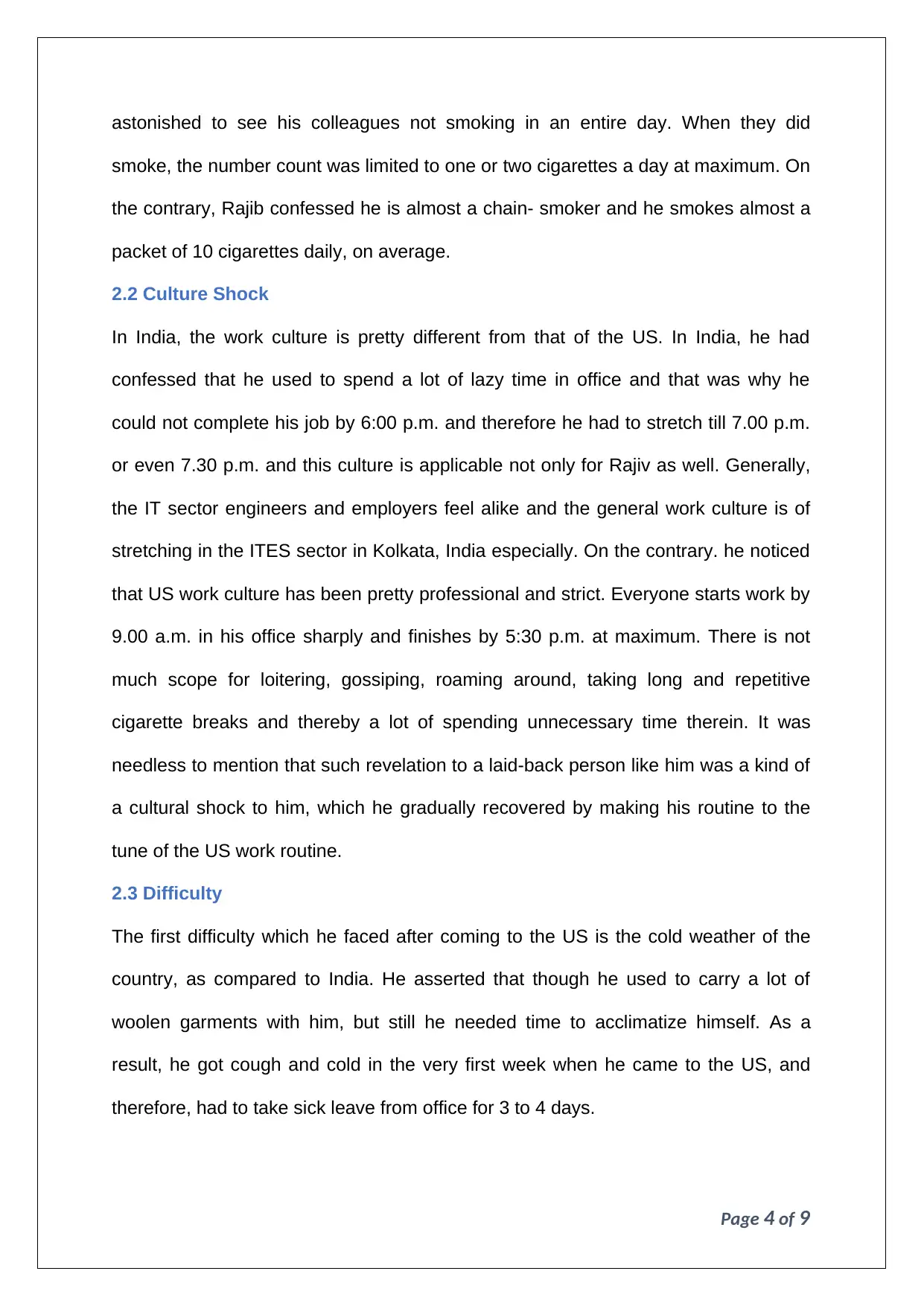
astonished to see his colleagues not smoking in an entire day. When they did
smoke, the number count was limited to one or two cigarettes a day at maximum. On
the contrary, Rajib confessed he is almost a chain- smoker and he smokes almost a
packet of 10 cigarettes daily, on average.
2.2 Culture Shock
In India, the work culture is pretty different from that of the US. In India, he had
confessed that he used to spend a lot of lazy time in office and that was why he
could not complete his job by 6:00 p.m. and therefore he had to stretch till 7.00 p.m.
or even 7.30 p.m. and this culture is applicable not only for Rajiv as well. Generally,
the IT sector engineers and employers feel alike and the general work culture is of
stretching in the ITES sector in Kolkata, India especially. On the contrary. he noticed
that US work culture has been pretty professional and strict. Everyone starts work by
9.00 a.m. in his office sharply and finishes by 5:30 p.m. at maximum. There is not
much scope for loitering, gossiping, roaming around, taking long and repetitive
cigarette breaks and thereby a lot of spending unnecessary time therein. It was
needless to mention that such revelation to a laid-back person like him was a kind of
a cultural shock to him, which he gradually recovered by making his routine to the
tune of the US work routine.
2.3 Difficulty
The first difficulty which he faced after coming to the US is the cold weather of the
country, as compared to India. He asserted that though he used to carry a lot of
woolen garments with him, but still he needed time to acclimatize himself. As a
result, he got cough and cold in the very first week when he came to the US, and
therefore, had to take sick leave from office for 3 to 4 days.
Page 4 of 9
smoke, the number count was limited to one or two cigarettes a day at maximum. On
the contrary, Rajib confessed he is almost a chain- smoker and he smokes almost a
packet of 10 cigarettes daily, on average.
2.2 Culture Shock
In India, the work culture is pretty different from that of the US. In India, he had
confessed that he used to spend a lot of lazy time in office and that was why he
could not complete his job by 6:00 p.m. and therefore he had to stretch till 7.00 p.m.
or even 7.30 p.m. and this culture is applicable not only for Rajiv as well. Generally,
the IT sector engineers and employers feel alike and the general work culture is of
stretching in the ITES sector in Kolkata, India especially. On the contrary. he noticed
that US work culture has been pretty professional and strict. Everyone starts work by
9.00 a.m. in his office sharply and finishes by 5:30 p.m. at maximum. There is not
much scope for loitering, gossiping, roaming around, taking long and repetitive
cigarette breaks and thereby a lot of spending unnecessary time therein. It was
needless to mention that such revelation to a laid-back person like him was a kind of
a cultural shock to him, which he gradually recovered by making his routine to the
tune of the US work routine.
2.3 Difficulty
The first difficulty which he faced after coming to the US is the cold weather of the
country, as compared to India. He asserted that though he used to carry a lot of
woolen garments with him, but still he needed time to acclimatize himself. As a
result, he got cough and cold in the very first week when he came to the US, and
therefore, had to take sick leave from office for 3 to 4 days.
Page 4 of 9
Paraphrase This Document
Need a fresh take? Get an instant paraphrase of this document with our AI Paraphraser
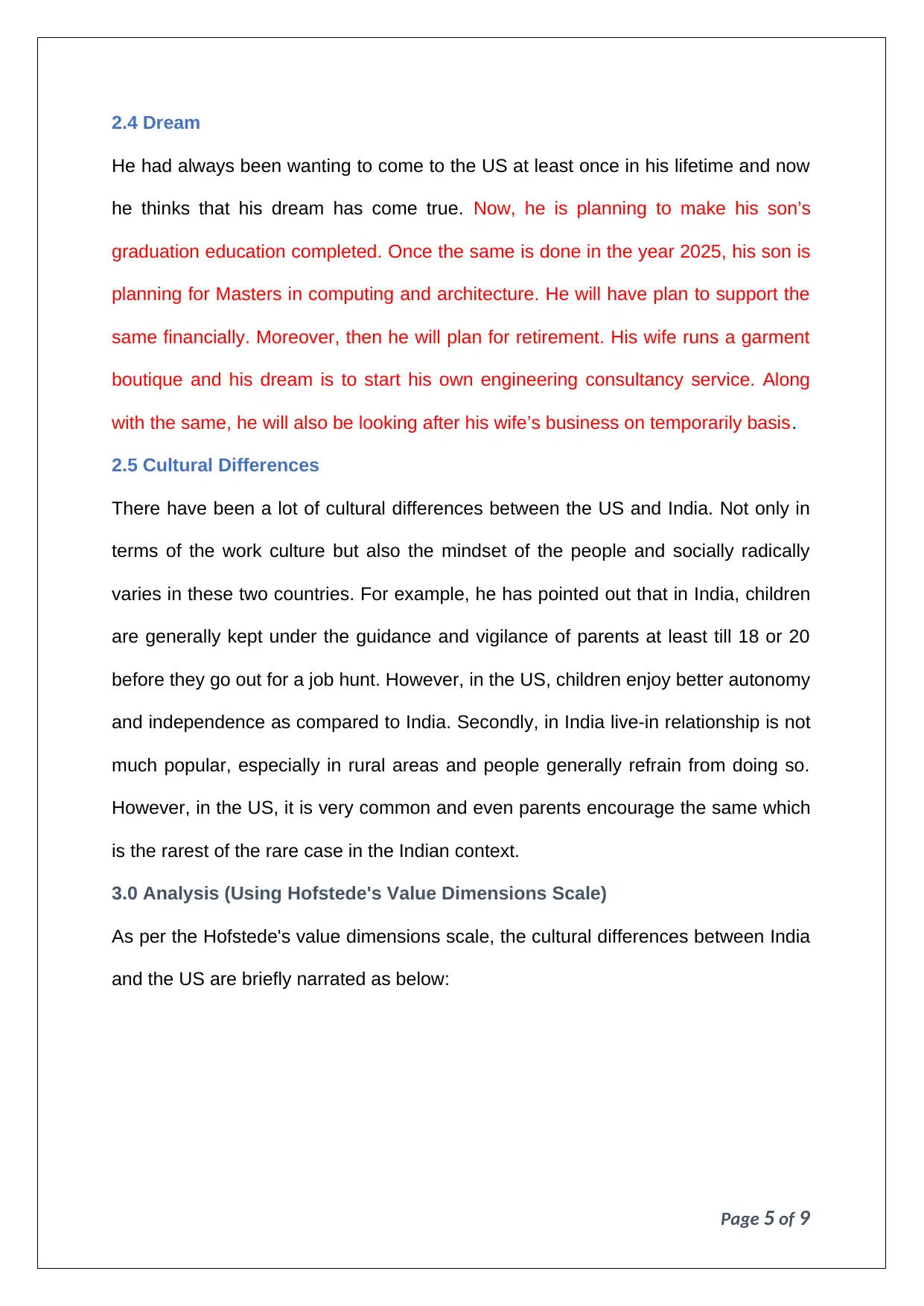
2.4 Dream
He had always been wanting to come to the US at least once in his lifetime and now
he thinks that his dream has come true. Now, he is planning to make his son’s
graduation education completed. Once the same is done in the year 2025, his son is
planning for Masters in computing and architecture. He will have plan to support the
same financially. Moreover, then he will plan for retirement. His wife runs a garment
boutique and his dream is to start his own engineering consultancy service. Along
with the same, he will also be looking after his wife’s business on temporarily basis.
2.5 Cultural Differences
There have been a lot of cultural differences between the US and India. Not only in
terms of the work culture but also the mindset of the people and socially radically
varies in these two countries. For example, he has pointed out that in India, children
are generally kept under the guidance and vigilance of parents at least till 18 or 20
before they go out for a job hunt. However, in the US, children enjoy better autonomy
and independence as compared to India. Secondly, in India live-in relationship is not
much popular, especially in rural areas and people generally refrain from doing so.
However, in the US, it is very common and even parents encourage the same which
is the rarest of the rare case in the Indian context.
3.0 Analysis (Using Hofstede's Value Dimensions Scale)
As per the Hofstede's value dimensions scale, the cultural differences between India
and the US are briefly narrated as below:
Page 5 of 9
He had always been wanting to come to the US at least once in his lifetime and now
he thinks that his dream has come true. Now, he is planning to make his son’s
graduation education completed. Once the same is done in the year 2025, his son is
planning for Masters in computing and architecture. He will have plan to support the
same financially. Moreover, then he will plan for retirement. His wife runs a garment
boutique and his dream is to start his own engineering consultancy service. Along
with the same, he will also be looking after his wife’s business on temporarily basis.
2.5 Cultural Differences
There have been a lot of cultural differences between the US and India. Not only in
terms of the work culture but also the mindset of the people and socially radically
varies in these two countries. For example, he has pointed out that in India, children
are generally kept under the guidance and vigilance of parents at least till 18 or 20
before they go out for a job hunt. However, in the US, children enjoy better autonomy
and independence as compared to India. Secondly, in India live-in relationship is not
much popular, especially in rural areas and people generally refrain from doing so.
However, in the US, it is very common and even parents encourage the same which
is the rarest of the rare case in the Indian context.
3.0 Analysis (Using Hofstede's Value Dimensions Scale)
As per the Hofstede's value dimensions scale, the cultural differences between India
and the US are briefly narrated as below:
Page 5 of 9
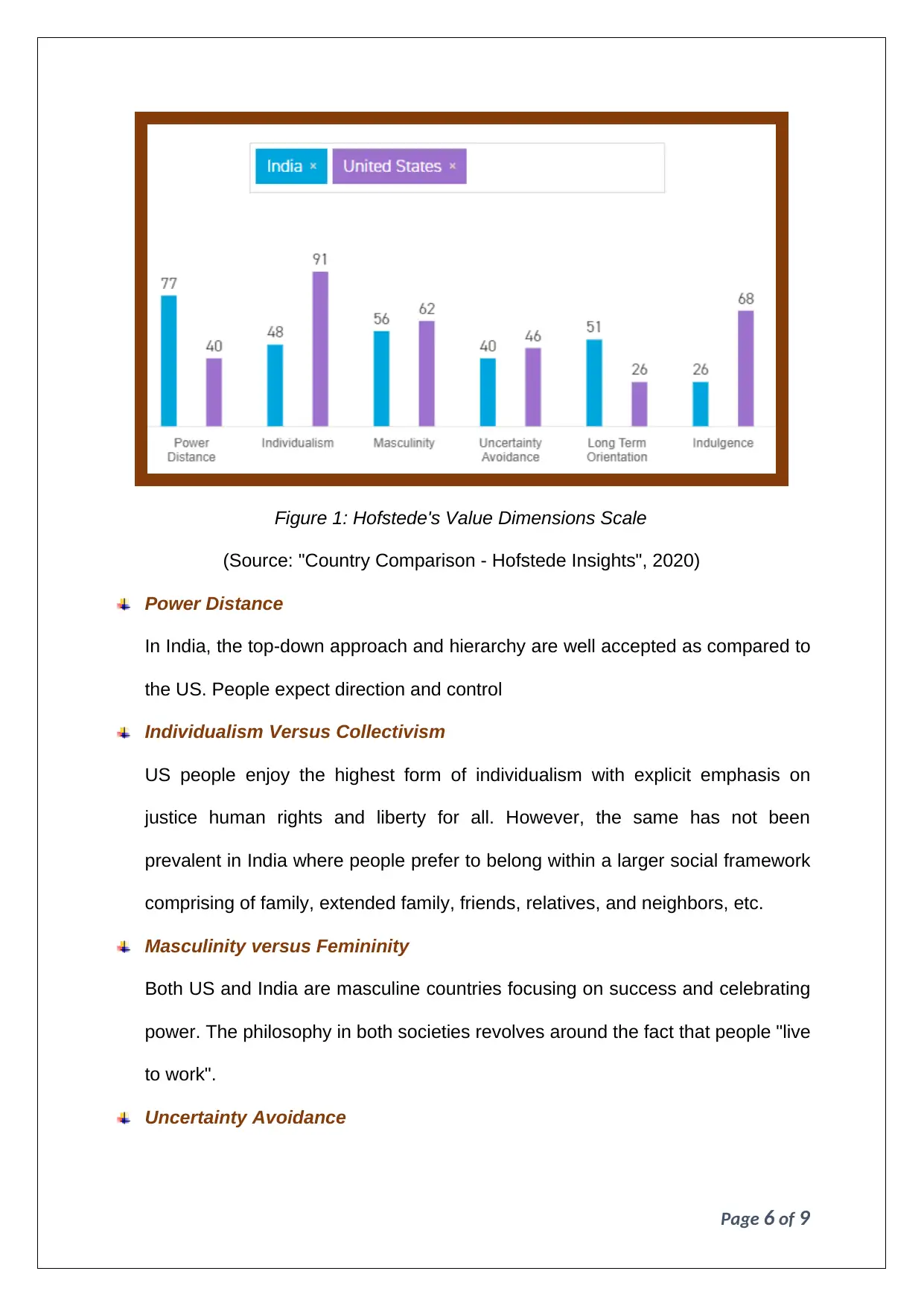
Figure 1: Hofstede's Value Dimensions Scale
(Source: "Country Comparison - Hofstede Insights", 2020)
Power Distance
In India, the top-down approach and hierarchy are well accepted as compared to
the US. People expect direction and control
Individualism Versus Collectivism
US people enjoy the highest form of individualism with explicit emphasis on
justice human rights and liberty for all. However, the same has not been
prevalent in India where people prefer to belong within a larger social framework
comprising of family, extended family, friends, relatives, and neighbors, etc.
Masculinity versus Femininity
Both US and India are masculine countries focusing on success and celebrating
power. The philosophy in both societies revolves around the fact that people "live
to work".
Uncertainty Avoidance
Page 6 of 9
(Source: "Country Comparison - Hofstede Insights", 2020)
Power Distance
In India, the top-down approach and hierarchy are well accepted as compared to
the US. People expect direction and control
Individualism Versus Collectivism
US people enjoy the highest form of individualism with explicit emphasis on
justice human rights and liberty for all. However, the same has not been
prevalent in India where people prefer to belong within a larger social framework
comprising of family, extended family, friends, relatives, and neighbors, etc.
Masculinity versus Femininity
Both US and India are masculine countries focusing on success and celebrating
power. The philosophy in both societies revolves around the fact that people "live
to work".
Uncertainty Avoidance
Page 6 of 9
⊘ This is a preview!⊘
Do you want full access?
Subscribe today to unlock all pages.

Trusted by 1+ million students worldwide
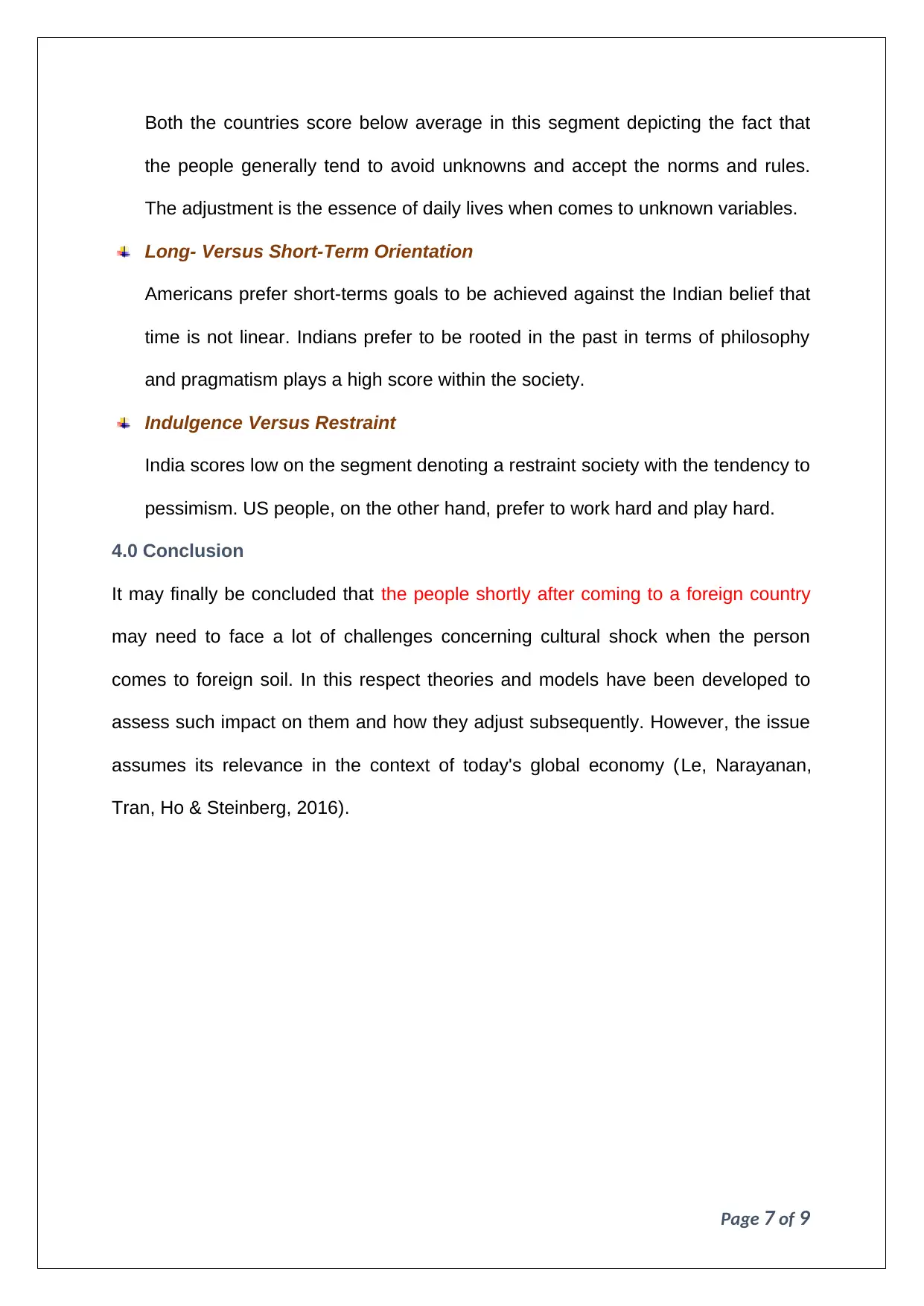
Both the countries score below average in this segment depicting the fact that
the people generally tend to avoid unknowns and accept the norms and rules.
The adjustment is the essence of daily lives when comes to unknown variables.
Long- Versus Short-Term Orientation
Americans prefer short-terms goals to be achieved against the Indian belief that
time is not linear. Indians prefer to be rooted in the past in terms of philosophy
and pragmatism plays a high score within the society.
Indulgence Versus Restraint
India scores low on the segment denoting a restraint society with the tendency to
pessimism. US people, on the other hand, prefer to work hard and play hard.
4.0 Conclusion
It may finally be concluded that the people shortly after coming to a foreign country
may need to face a lot of challenges concerning cultural shock when the person
comes to foreign soil. In this respect theories and models have been developed to
assess such impact on them and how they adjust subsequently. However, the issue
assumes its relevance in the context of today's global economy (Le, Narayanan,
Tran, Ho & Steinberg, 2016).
Page 7 of 9
the people generally tend to avoid unknowns and accept the norms and rules.
The adjustment is the essence of daily lives when comes to unknown variables.
Long- Versus Short-Term Orientation
Americans prefer short-terms goals to be achieved against the Indian belief that
time is not linear. Indians prefer to be rooted in the past in terms of philosophy
and pragmatism plays a high score within the society.
Indulgence Versus Restraint
India scores low on the segment denoting a restraint society with the tendency to
pessimism. US people, on the other hand, prefer to work hard and play hard.
4.0 Conclusion
It may finally be concluded that the people shortly after coming to a foreign country
may need to face a lot of challenges concerning cultural shock when the person
comes to foreign soil. In this respect theories and models have been developed to
assess such impact on them and how they adjust subsequently. However, the issue
assumes its relevance in the context of today's global economy (Le, Narayanan,
Tran, Ho & Steinberg, 2016).
Page 7 of 9
Paraphrase This Document
Need a fresh take? Get an instant paraphrase of this document with our AI Paraphraser
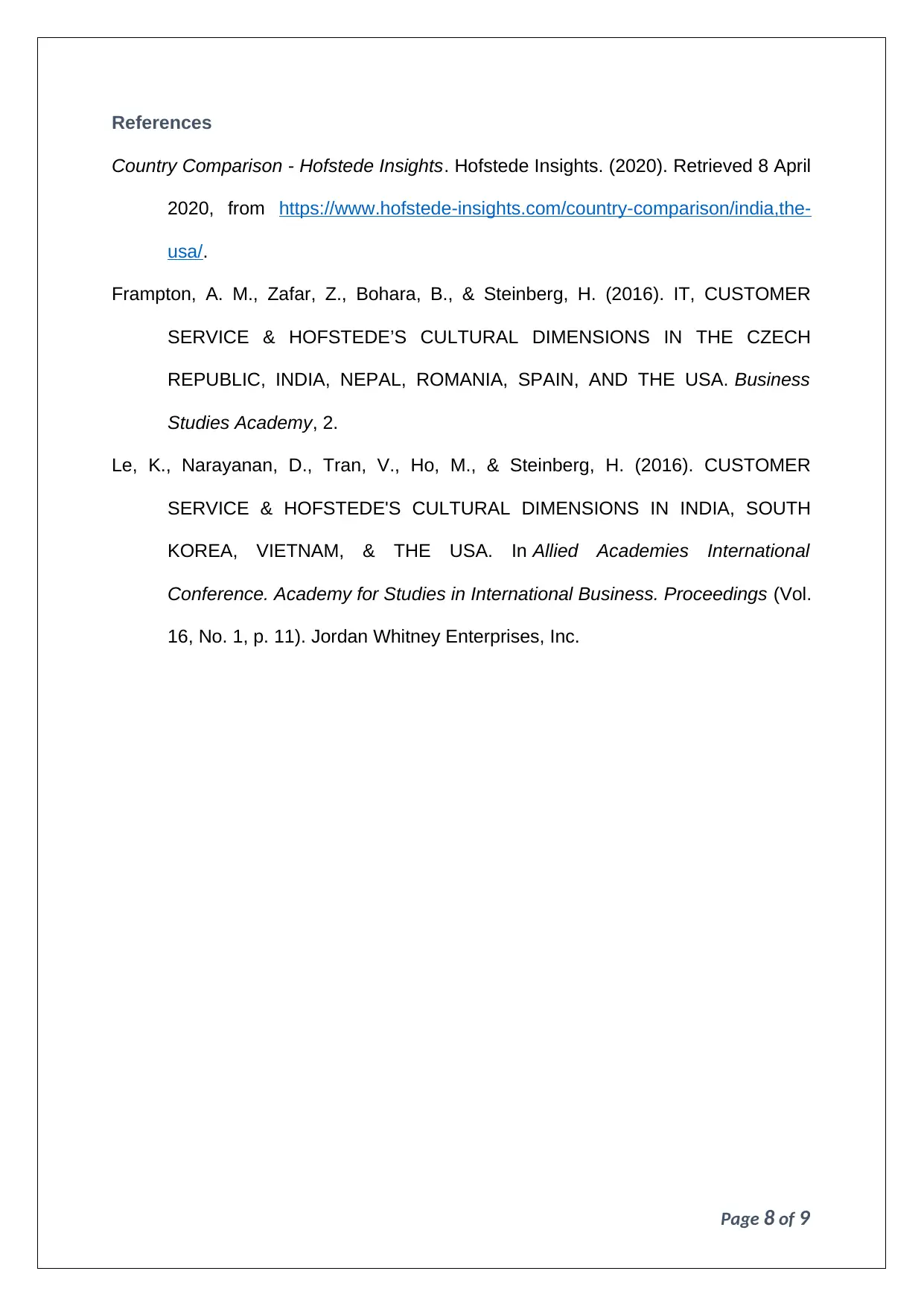
References
Country Comparison - Hofstede Insights. Hofstede Insights. (2020). Retrieved 8 April
2020, from https://www.hofstede-insights.com/country-comparison/india,the-
usa/.
Frampton, A. M., Zafar, Z., Bohara, B., & Steinberg, H. (2016). IT, CUSTOMER
SERVICE & HOFSTEDE’S CULTURAL DIMENSIONS IN THE CZECH
REPUBLIC, INDIA, NEPAL, ROMANIA, SPAIN, AND THE USA. Business
Studies Academy, 2.
Le, K., Narayanan, D., Tran, V., Ho, M., & Steinberg, H. (2016). CUSTOMER
SERVICE & HOFSTEDE'S CULTURAL DIMENSIONS IN INDIA, SOUTH
KOREA, VIETNAM, & THE USA. In Allied Academies International
Conference. Academy for Studies in International Business. Proceedings (Vol.
16, No. 1, p. 11). Jordan Whitney Enterprises, Inc.
Page 8 of 9
Country Comparison - Hofstede Insights. Hofstede Insights. (2020). Retrieved 8 April
2020, from https://www.hofstede-insights.com/country-comparison/india,the-
usa/.
Frampton, A. M., Zafar, Z., Bohara, B., & Steinberg, H. (2016). IT, CUSTOMER
SERVICE & HOFSTEDE’S CULTURAL DIMENSIONS IN THE CZECH
REPUBLIC, INDIA, NEPAL, ROMANIA, SPAIN, AND THE USA. Business
Studies Academy, 2.
Le, K., Narayanan, D., Tran, V., Ho, M., & Steinberg, H. (2016). CUSTOMER
SERVICE & HOFSTEDE'S CULTURAL DIMENSIONS IN INDIA, SOUTH
KOREA, VIETNAM, & THE USA. In Allied Academies International
Conference. Academy for Studies in International Business. Proceedings (Vol.
16, No. 1, p. 11). Jordan Whitney Enterprises, Inc.
Page 8 of 9
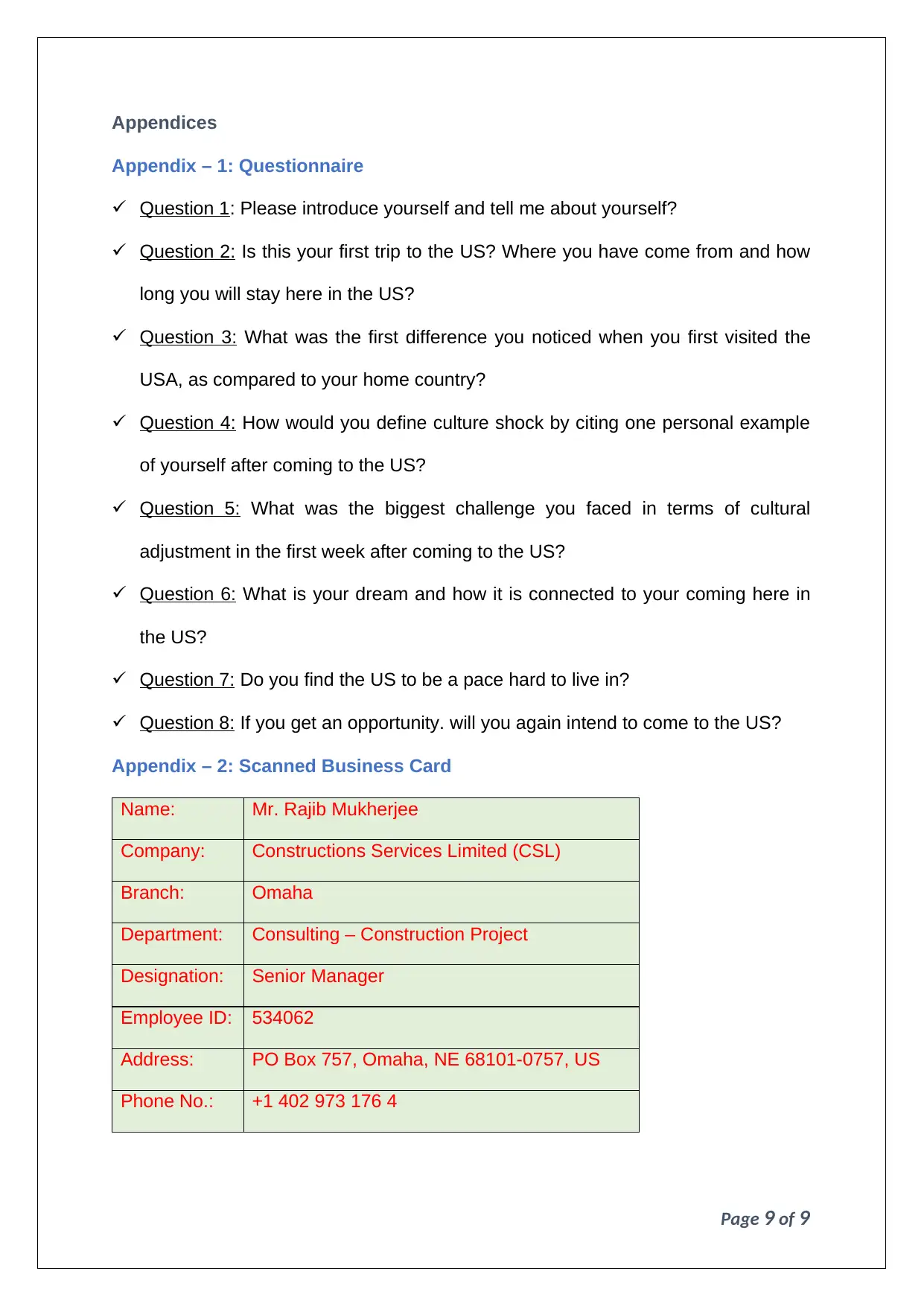
Appendices
Appendix – 1: Questionnaire
Question 1: Please introduce yourself and tell me about yourself?
Question 2: Is this your first trip to the US? Where you have come from and how
long you will stay here in the US?
Question 3: What was the first difference you noticed when you first visited the
USA, as compared to your home country?
Question 4: How would you define culture shock by citing one personal example
of yourself after coming to the US?
Question 5: What was the biggest challenge you faced in terms of cultural
adjustment in the first week after coming to the US?
Question 6: What is your dream and how it is connected to your coming here in
the US?
Question 7: Do you find the US to be a pace hard to live in?
Question 8: If you get an opportunity. will you again intend to come to the US?
Appendix – 2: Scanned Business Card
Name: Mr. Rajib Mukherjee
Company: Constructions Services Limited (CSL)
Branch: Omaha
Department: Consulting – Construction Project
Designation: Senior Manager
Employee ID: 534062
Address: PO Box 757, Omaha, NE 68101-0757, US
Phone No.: +1 402 973 176 4
Page 9 of 9
Appendix – 1: Questionnaire
Question 1: Please introduce yourself and tell me about yourself?
Question 2: Is this your first trip to the US? Where you have come from and how
long you will stay here in the US?
Question 3: What was the first difference you noticed when you first visited the
USA, as compared to your home country?
Question 4: How would you define culture shock by citing one personal example
of yourself after coming to the US?
Question 5: What was the biggest challenge you faced in terms of cultural
adjustment in the first week after coming to the US?
Question 6: What is your dream and how it is connected to your coming here in
the US?
Question 7: Do you find the US to be a pace hard to live in?
Question 8: If you get an opportunity. will you again intend to come to the US?
Appendix – 2: Scanned Business Card
Name: Mr. Rajib Mukherjee
Company: Constructions Services Limited (CSL)
Branch: Omaha
Department: Consulting – Construction Project
Designation: Senior Manager
Employee ID: 534062
Address: PO Box 757, Omaha, NE 68101-0757, US
Phone No.: +1 402 973 176 4
Page 9 of 9
⊘ This is a preview!⊘
Do you want full access?
Subscribe today to unlock all pages.

Trusted by 1+ million students worldwide
1 out of 9
Your All-in-One AI-Powered Toolkit for Academic Success.
+13062052269
info@desklib.com
Available 24*7 on WhatsApp / Email
![[object Object]](/_next/static/media/star-bottom.7253800d.svg)
Unlock your academic potential
Copyright © 2020–2025 A2Z Services. All Rights Reserved. Developed and managed by ZUCOL.